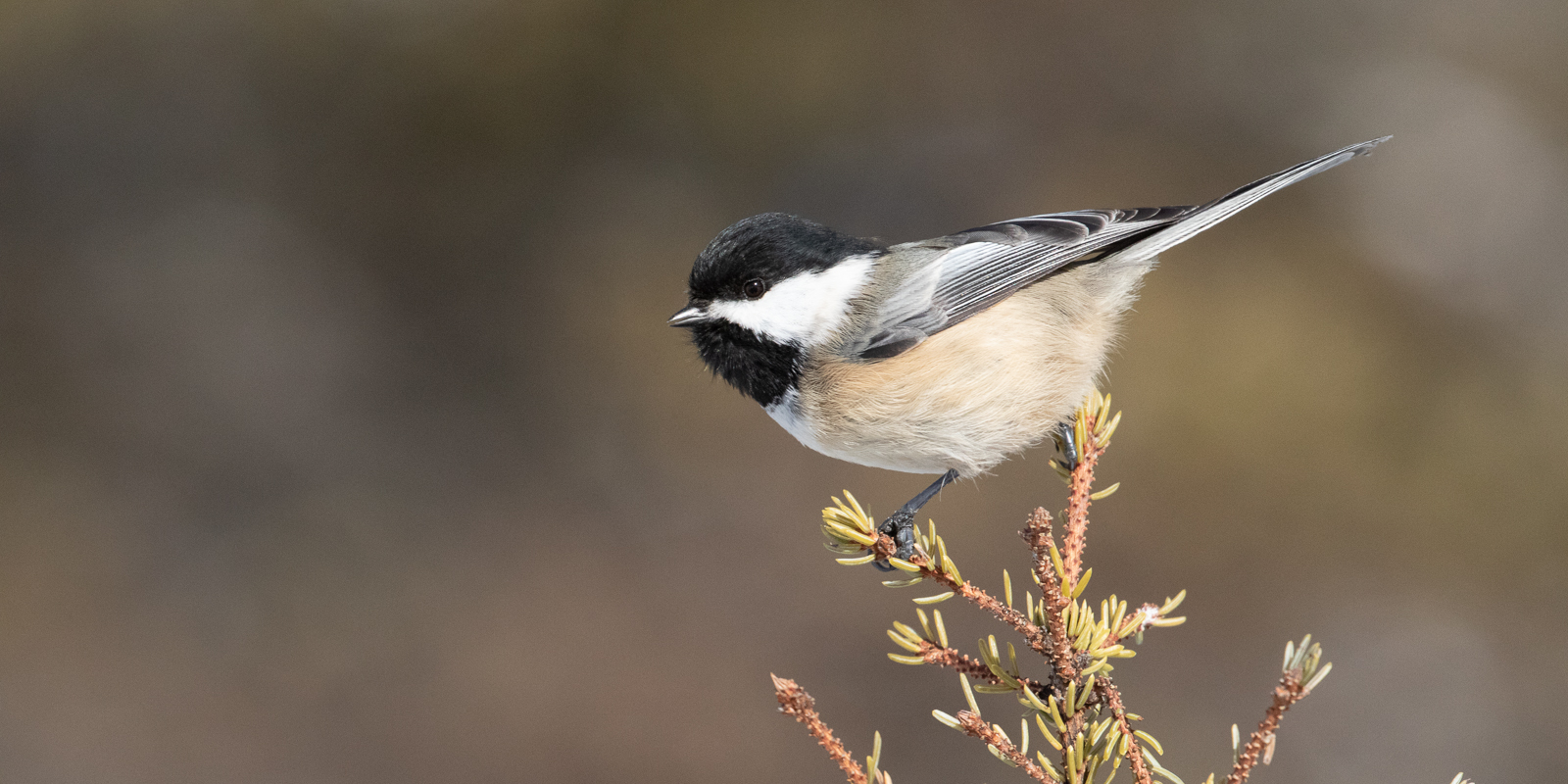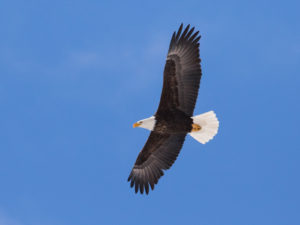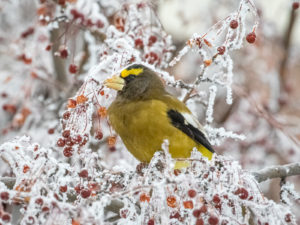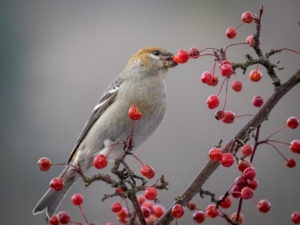The Plainfield Christmas Bird Count: Reflections on 60 Years of Birding

The Christmas Bird Count is a global community science project organized by the National Audubon Society. At 121 years old, it is the longest-running project of its kind. In the weeks surrounding Christmas, groups fan out over established 15-mile-wide count circles with the mission of finding every feathered creature therein. While new circles are added to the count every year as birding grows in popularity, our Plainfield Circle (spanning from Montpelier east into Groton State Forest) is among Vermont’s oldest, celebrating its 60th anniversary last Saturday. In celebration of this milestone, we dove into the historical data to highlight some interesting trends from six decades of birding. Many of the fascinating findings were inspired by some remarkable sightings from last Saturday’s annual count.
Owls turned up in great numbers this year thanks to unprecedented nocturnal survey effort and scouting. Our caffeine-fueled owling team documented three Great Horned Owls, a species sighted only six times in the circle’s history, and never more than one a year. While common in the Champlain and Connecticut River Valleys, this owl is scarce in the heart of the Green Mountains.
Later that night, while the rest of the county slept, the team documented two different Long-eared Owls. Not only was this a record number for a single count, but there has only been one previous Plainfield CBC sighting of this species back in 2015. Long-eared Owls are both cryptic and quiet. A better understanding of their behavior and habitat niche, thanks to the efforts of the Vermont birding community in recent years, helped us hone likely locations where Long-eareds reside in our area.
Finally, the team heard the whinnying alarm call from a Northern Saw-whet Owl, a species seen on only once 32 years ago. Saw-whets are rare here in the winter, they migrate through Central Vermont in huge numbers each fall. Our team here at NBNC catches and studies hundreds of saw-whets each year, and offers an “adopt-an-owl” program to support this research. This is also the same species that made national news when “Rocky” was found roosting in the Christmas tree in Rockefeller Center last month. Learn more about Rocky’s story and whereabouts today in our recent interview with Audubon. We’d like to extend a huge thanks for the efforts and scouting of our owling team: Richard Littauer, Spencer Hardy, Ken Benton, and Chip and Charlie Darmstadt.
This year’s volunteers also documented a rare Black-backed Woodpecker on the side of Spruce Mountain. While this species has turned up on four occasions over the count’s 60-year history, it hasn’t been reported on a count since 1990. In fact, the most recent report of this boreal bird in this area was ten years ago. Black-backed woodpeckers are a member of the “Boreal Grand Slam,” a quartet of four species usually found only in Vermont’s coldest regions among the spruce and fir forests of the Northeast Kingdom. Boreal Chickadee, Gray Jay, and Spruce Grouse make up the rest of the suite. Birders searching for these today must travel all the way to the Silvio O. Conte National Wildlife Refuge beyond Island Pond. Yet these species have all been historically reported within the Plainfield CBC circle. Boreal chickadees have been seen in 15 different years. Gray jays twice. Even the exceedingly rare Spruce Grouse was seen on two occasions. Until Saturday, no “grand slam” bird had been seen in the Plainfield CBC since 2004.
 Common Redpolls made their first appearance in the count circle since 2013. These nomadic winter finches from Canada turn up in Vermont most winters, but a cyclical, major irruptive influx into our region hasn’t occurred in quite some time. A single chirp from a flyover Snow Bunting in Plainfield clinched the first circle sighting of this species in ten years, even though this species was reported in large flocks most years through the ‘80s, and occasionally through the ‘90s. Though development in Washington County has been low compared to elsewhere in Vermont, the decline of big open fields and changes in agricultural practices across the northeast may be responsible for the scarcity of Snow Buntings.
Common Redpolls made their first appearance in the count circle since 2013. These nomadic winter finches from Canada turn up in Vermont most winters, but a cyclical, major irruptive influx into our region hasn’t occurred in quite some time. A single chirp from a flyover Snow Bunting in Plainfield clinched the first circle sighting of this species in ten years, even though this species was reported in large flocks most years through the ‘80s, and occasionally through the ‘90s. Though development in Washington County has been low compared to elsewhere in Vermont, the decline of big open fields and changes in agricultural practices across the northeast may be responsible for the scarcity of Snow Buntings.
 This year tied 2018’s high count of 3 Bald Eagles. Freshly removed from the Vermont Endangered Species List last month, eagles have been sighted regularly in the circle since 2004. Just a year before that, Vermont began a federally-funded reintroduction project in Addison County. In that same year, eagles born in neighboring states began nesting here on their own. Prior to this turning point in Vermont conservation history, the only eagle sighted in the history of the Plainfield CBC was a single bird in 1988. Though eagles tend to attract major media attention, Wild Turkeys have a very similar and successful conservation story in the northeast. Extinguished from Vermont due to overhunting in the 18th and 19th centuries, Wild Turkeys were reintroduced to southern Vermont in 1970. Once they finally made their way into Washington County in 1991, they have been seen every year since. This year tallied a healthy 262 birds.
This year tied 2018’s high count of 3 Bald Eagles. Freshly removed from the Vermont Endangered Species List last month, eagles have been sighted regularly in the circle since 2004. Just a year before that, Vermont began a federally-funded reintroduction project in Addison County. In that same year, eagles born in neighboring states began nesting here on their own. Prior to this turning point in Vermont conservation history, the only eagle sighted in the history of the Plainfield CBC was a single bird in 1988. Though eagles tend to attract major media attention, Wild Turkeys have a very similar and successful conservation story in the northeast. Extinguished from Vermont due to overhunting in the 18th and 19th centuries, Wild Turkeys were reintroduced to southern Vermont in 1970. Once they finally made their way into Washington County in 1991, they have been seen every year since. This year tallied a healthy 262 birds.
 The Vermont birding community has been abuzz with sightings of the dazzling Evening Grosbeaks this winter. Like the Redpolls, this grosbeak is a nomadic winter visitor that “irrupts” southward in large flocks in cyclical patterns tied to food availability farther north. This year’s tally of 73 Evening Grosbeaks marks the highest in the last 14 years. For younger generations of birders, this has felt like a banner year for this special species. But this bird regularly peaked at over 1,000 sightings per count through the ‘70s and ‘80s. Reasons for this decline may include warmer temperatures that keep these birds farther north during the winter, and large-scale insecticide control for Spruce Budworm across large swaths of Canadian boreal forest. A major pest for the timber industry, the native budworm is a staple food for the grosbeaks. Curiously, Evening Grosbeaks were rarely reported in New England until the 1970s. Was this increase due to more bird feeders and the suburban planting of maples and boxelders, a choice winter food? Was it due to a multi-decade ebb-and-flow of budworm populations? These questions have scientists studying whether today’s decline is explained by natural, long-term population variability, or the evidence of human-caused population collapse.
The Vermont birding community has been abuzz with sightings of the dazzling Evening Grosbeaks this winter. Like the Redpolls, this grosbeak is a nomadic winter visitor that “irrupts” southward in large flocks in cyclical patterns tied to food availability farther north. This year’s tally of 73 Evening Grosbeaks marks the highest in the last 14 years. For younger generations of birders, this has felt like a banner year for this special species. But this bird regularly peaked at over 1,000 sightings per count through the ‘70s and ‘80s. Reasons for this decline may include warmer temperatures that keep these birds farther north during the winter, and large-scale insecticide control for Spruce Budworm across large swaths of Canadian boreal forest. A major pest for the timber industry, the native budworm is a staple food for the grosbeaks. Curiously, Evening Grosbeaks were rarely reported in New England until the 1970s. Was this increase due to more bird feeders and the suburban planting of maples and boxelders, a choice winter food? Was it due to a multi-decade ebb-and-flow of budworm populations? These questions have scientists studying whether today’s decline is explained by natural, long-term population variability, or the evidence of human-caused population collapse.
 Reporting “raw numbers” when explaining data trends can be misleading when volunteer effort varies widely from year to year. But our historical effort data showed that our Plainfield CBC has been consistently popular right from the beginning. These interesting findings are made possible by all those who have participated in the Plainfield CBC over the last 60 years. We’d like to thank everyone who has ever participated in this project. A special thanks to the 55 volunteers who scoured every tree, bush, and feeder last weekend, discovering a whopping 4,580 birds of 46 different species.
Reporting “raw numbers” when explaining data trends can be misleading when volunteer effort varies widely from year to year. But our historical effort data showed that our Plainfield CBC has been consistently popular right from the beginning. These interesting findings are made possible by all those who have participated in the Plainfield CBC over the last 60 years. We’d like to thank everyone who has ever participated in this project. A special thanks to the 55 volunteers who scoured every tree, bush, and feeder last weekend, discovering a whopping 4,580 birds of 46 different species.

